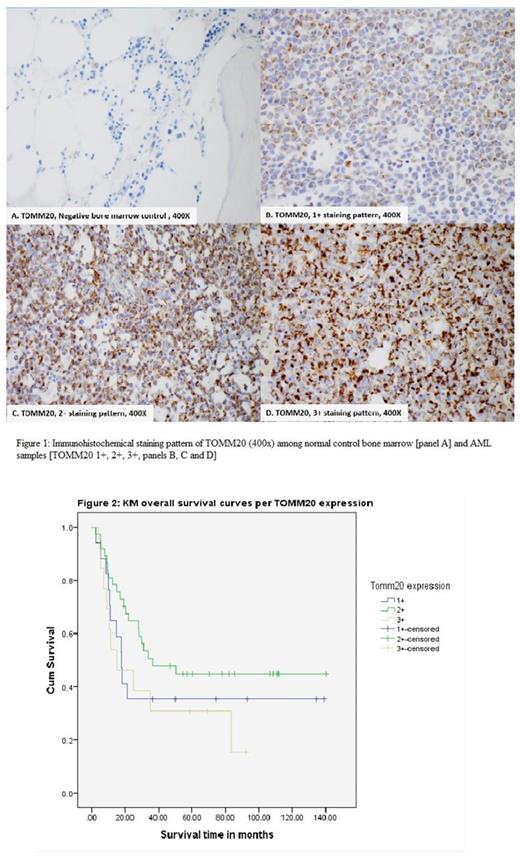Abstract
Introduction:
Acute myeloid leukemia (AML) is a clonal hematopoietic malignancy characterized by dysregulated differentiation, unrestricted growth, and inhibition of apoptosis of immature myeloid progenitors. A feature in AML is increased metabolic demand despite genetic heterogeneity. Mitochondria regulate ATP generation, metabolism, apoptosis and are central to proliferation and differentiation in normal and cancer cells. The Translocase of the Outer Mitochondrial Membrane Member 20 (TOMM20), a member of the outer membrane translocator complex, plays a critical role in import of precursor proteins like nuclear encoded oxidative phosphorylation (OXPHOS) subunits from cytosol to mitochondria, required for ATP generation. TOMM20 expression and uptake of the mitotracker (a fluorescent dye taken up by mitochondria with intact membrane potential), correlate with functional mitochondrial mass and OXPHOS activity. We aim to characterize the metabolic profile of AML, using TOMM20 as a surrogate marker of mitochondrial OXPHOS, and to assess in a subgroup of subjects, differences in mitotracker uptake between AML and non-cancer cells.
Methods:
This is a retrospective evaluation of 67 patients with AML treated at Thomas Jefferson University between 2005 and 2015. The patients were divided into 3 cohorts with (a) relapsed disease post-hematopoietic stem cell transplantation (HSCT) [n=20], (b) remission post-HSCT [n=27] and (c) refractory disease post induction therapy [n=20].
The study hypotheses were: (1) Mitochondrial metabolism measured by TOMM20 expression is increased in AML compared to normal bone marrow biopsy specimens and there is higher mitotracker uptake in AML cells than non-cancer bone marrow cells (2) Biologic behavior of AML can be predicted by TOMM20 expression with patients who relapse having higher expression than those that maintain a remission and (3) At relapse, there will be an increase in TOMM20 expression from initial diagnosis with the patient serving as his/her own control. Immunostaining of TOMM20 in bone marrow specimens was graded by two pathologists (blinded to clinical characteristics) as 1+: faint fine granular staining in areas of maximum staining, 2+: coarse granular staining with distinctly visible granules in areas of maximum staining and 3+: coarse coalesced granular staining in areas of maximum staining. Overall survival in relation to TOMM20 expression was measured.
The association of TOMM20 expression with unpaired categorical data was performed using chi-square or Fisher's exact test and paired data using the non-parametric Wilcoxon rank-sum test. Kaplan-Meier test was used to evaluate survival rates and compared using the log-rank test. Mitotracker deep red mean fluorescent intensity in CD34+ and CD34 bone marrow cells in AML were compared using a paired t-test.
Results:
The median age at AML diagnosis was 58 (range: 20-78) years and 63% were female. Per the Revised Disease Risk Index, patients fell into low (13%), intermediate (64%) and high (23%) risk groups. In the control bone marrow specimens analyzed (n=6), only scattered myeloid precursors showed 1+ TOMM20 expression compared to AML blasts that showed uniform 1+ to 3+ staining [figure 1]. Mitotracker uptake was 7.7 fold higher (p<0.05) in AML cells than in non-cancer bone marrow cells in 5 subjects with AML whose cancer cells expressed CD34.
There was no significant difference in TOMM20 expression between the 3 patient groups at diagnosis (p=0.26). In the patient group relapsing post HSCT, there was a statistically significant increase in median TOMM20 expression compared to baseline (Z=-3.2, p=0.001). Patients with high TOMM20 expression (3+) had the lowest overall survival compared to those with 1+ or 2+ expression, although not statistically significant (Log rank p value=0.217) [figure 2].
Discussion:
We demonstrate that AML blasts have increased TOMM20 expression and mitotracker uptake, markers of mitochondrial metabolism, compared to normal myeloid precursors. We did not observe a significant difference in TOMM20 expression at diagnosis between patient cohorts. In AML patients who relapse post HSCT, there is an increase in functional mitochondrial mass as demonstrated by increased expression of TOMM20. Mitochondrial OXPHOS inhibitors are promising oncotherapeutic agents warranting prospective evaluation in treatment strategies for relapsed and/or refractory AML.
No relevant conflicts of interest to declare.
Author notes
Asterisk with author names denotes non-ASH members.


This feature is available to Subscribers Only
Sign In or Create an Account Close Modal